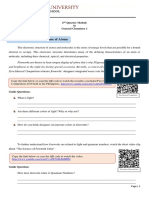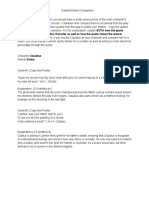Sample Research Article Review
Sample Research Article Review
Uploaded by
Anonymous FAy7usZZCopyright:
Available Formats
Sample Research Article Review
Sample Research Article Review
Uploaded by
Anonymous FAy7usZZOriginal Title
Copyright
Available Formats
Share this document
Did you find this document useful?
Is this content inappropriate?
Copyright:
Available Formats
Sample Research Article Review
Sample Research Article Review
Uploaded by
Anonymous FAy7usZZCopyright:
Available Formats
Sample Research Article Review
British philosopher Gilbert Ryle attempted to define the seemingly straightforward concept of
feelings in his 1951 essay.[1] During that time period, psychology and psychiatry had risen
as popular fields, but little work had been done to actually define the components of an
emotion or a feeling. Consequently, Ryle set out to establish some constrains on this
nebulous subject by suggesting that feelings are distinguished by various bodily or mental
sensations.
In the first section of this article, Ryle presented seven distinct conceptions of feelings. It is
clear that he put much contemplation in this presentation, for he named usages that would
typically escape most people. He began with the common definition of feelings as sensory
perception, but he distinguished between uncontrollable instinctual bodily responses (e.g.,
feeling cold or feeling an itch) and purposeful, thought-out motions to find an object or
determine something about an object (e.g., feeling water with ones fingers to figure out its
temperature). In another definition, Ryle distinguished between feeling bodily sensations and
feeling general conditions, such as sleepy, ill, wide-awake, uneasy, or depressed, deeming
the latter to be more mental.
Furthermore, Ryle included idiomatic phrases that incorporated conjugations of to feel to
remind readers how easy it is to forget figurative usages of common words. Theres feeling
that something is the case to express a gut inclination that is not yet strong enough to be
held as an actual thought or belief. Theres also feeling like doing something to express the
temptation one has to take an inappropriate action, such as falling asleep in class. These
figurative or hypothetical uses of feelings are easily overlooked, so Ryles thoughtful
inclusion brings useful philosophical insight for other researchers.
In the second and final section of this paper, Ryle expanded upon the various definitions of
feelings he advanced, discussing where the line blurred between each one. While his
meticulous analysis is largely palatable, his omission of the common notion of feeling does
not sit easily. In the entire article, he never mentions feeling an emotion, such as happy, sad,
or angry. Whether this was an intentional omission or a sloppy oversight is unclear, but it
weakens Ryles definition, as emotions are neither pure bodily states nor pure mental
sensations, and he provides no preemptive response to such arguments. Nevertheless,
Ryles work still provided the impetus for an ongoing debate about the nature of emotion.
You might also like
- Absent Excuse Letter For Not Attending ClassDocument2 pagesAbsent Excuse Letter For Not Attending Classsha_dydy83% (52)
- Ethnography ReviewDocument3 pagesEthnography Reviewiram shahzadi100% (1)
- What Happened To MondayDocument1 pageWhat Happened To MondayEhDieSoonNo ratings yet
- ON Done The Temple Luxor: Arthur WeigallDocument3 pagesON Done The Temple Luxor: Arthur WeigallPaul DugenouNo ratings yet
- Science, Technology and Society I RAUR Page - 1Document4 pagesScience, Technology and Society I RAUR Page - 1Jersey Ann Reign A. GabinNo ratings yet
- Interrelationship of Political Science With Other Branches of LearningDocument2 pagesInterrelationship of Political Science With Other Branches of LearningJeffrey Calicdan Bucala100% (1)
- Reviewer For Finals TCWDocument3 pagesReviewer For Finals TCWocampofranccine100% (1)
- Environmental ScienceDocument5 pagesEnvironmental ScienceKevin linsonNo ratings yet
- Fernando AmorsoloDocument3 pagesFernando AmorsoloRoland Maranan50% (2)
- Why Is Mathematical Language PowerfulDocument2 pagesWhy Is Mathematical Language PowerfulGena Alysa BariuanNo ratings yet
- Grade 11 ABM and STEM ExamDocument9 pagesGrade 11 ABM and STEM ExamkeyedNo ratings yet
- Culture and Society PDFDocument47 pagesCulture and Society PDFRose0% (1)
- Contemporary MidtermDocument6 pagesContemporary MidtermJhon Marvin ArienzaNo ratings yet
- Geel 11Document3 pagesGeel 11Paul Ivan EstologaNo ratings yet
- Partido State University: G3-Contemporary WorldDocument7 pagesPartido State University: G3-Contemporary WorldEmmanuel GarciaNo ratings yet
- Principles and Characteristics of Communication: By: Jenna Marie Lapuz Genevieve F. Desiderio BSMT1-4Document12 pagesPrinciples and Characteristics of Communication: By: Jenna Marie Lapuz Genevieve F. Desiderio BSMT1-4Genevieve DesiderioNo ratings yet
- Module 4 - Geography, Demography, and HistoryDocument7 pagesModule 4 - Geography, Demography, and HistoryRoxanne Enriquez FernandoNo ratings yet
- When Technology and Humanity CrossDocument14 pagesWhen Technology and Humanity CrossClaudette ClementeNo ratings yet
- KayedocxDocument7 pagesKayedocxKaye Kallean Porcino100% (1)
- Projectile MotionDocument36 pagesProjectile MotionChezka GuerzonNo ratings yet
- A Rose For Emily MarxistDocument3 pagesA Rose For Emily Marxistapi-288282286100% (1)
- Informative Essay 1Document1 pageInformative Essay 1Juan CuervoNo ratings yet
- SLG 2 - Earth ScienceDocument5 pagesSLG 2 - Earth ScienceJacob Kennedy LipuraNo ratings yet
- Lesson 3 Types of MediaDocument39 pagesLesson 3 Types of MediaArchi ArchiNo ratings yet
- VignetteDocument3 pagesVignetteVrick CielNo ratings yet
- MMW Reaction PaperDocument2 pagesMMW Reaction PaperMARY JOY CABRALNo ratings yet
- ACTIVITY #3: COMPARE ME UP! (20 Points)Document1 pageACTIVITY #3: COMPARE ME UP! (20 Points)Vionna BeaNo ratings yet
- Chapter-2 MMWDocument16 pagesChapter-2 MMWXeleen Elizabeth ArcaNo ratings yet
- Science, Technology and Society - Tertiary Books - Rex Bookstore IncDocument2 pagesScience, Technology and Society - Tertiary Books - Rex Bookstore IncHezel TrogoNo ratings yet
- Case Study FionaDocument9 pagesCase Study FionaAnonymous PilotsNo ratings yet
- Second EDSA RevolutionDocument25 pagesSecond EDSA RevolutionEDSEL ALAPAGNo ratings yet
- Models of Communication (ORAL COM)Document9 pagesModels of Communication (ORAL COM)Romar SayoNo ratings yet
- The Nineteenth Century World of Rizal: Activity 1Document7 pagesThe Nineteenth Century World of Rizal: Activity 1May Pearl BernaldezNo ratings yet
- Sts Chapter 5 When Technology and Humanity CrossDocument51 pagesSts Chapter 5 When Technology and Humanity CrossJay GoNo ratings yet
- STS Chapter 4 Environmental Awarenes and Climate ChangeDocument7 pagesSTS Chapter 4 Environmental Awarenes and Climate ChangepyaplauaanNo ratings yet
- Developmental Aspect of Reproductive SystemDocument11 pagesDevelopmental Aspect of Reproductive SystemFrancis ArceoNo ratings yet
- Written Speech (Public Speaking) INFORMATIVE SPEECH-Bautista AiriDocument3 pagesWritten Speech (Public Speaking) INFORMATIVE SPEECH-Bautista AiriAiri BautistaNo ratings yet
- Apolinario MabiniDocument4 pagesApolinario MabiniFaith MarasiganNo ratings yet
- Theory of BiogenesisDocument6 pagesTheory of BiogenesisScarlet OrigenesNo ratings yet
- Workbook ActivityDocument68 pagesWorkbook Activityazmin asriNo ratings yet
- Article 1, The Role of Science and TechnologyDocument3 pagesArticle 1, The Role of Science and TechnologyNSBMRNo ratings yet
- Ps 153 Reaction PaperDocument1 pagePs 153 Reaction PaperAlyanna CabralNo ratings yet
- Rehabilitation of Manila Bay Junes Gil GonzalesDocument2 pagesRehabilitation of Manila Bay Junes Gil GonzalesLebron IlokanoNo ratings yet
- Module 9 Global Migration Basic Concepts Week 9Document4 pagesModule 9 Global Migration Basic Concepts Week 9Celine Kaye Mendoza100% (1)
- Principles and Concept of EcosystemDocument16 pagesPrinciples and Concept of EcosystemJay Bianca Abera Alistado100% (1)
- Should Students Be Allowed To Grade Their TeachersDocument3 pagesShould Students Be Allowed To Grade Their TeachersTushar Rastogi100% (1)
- Syllabus For Science, Technology, and Society (STS)Document2 pagesSyllabus For Science, Technology, and Society (STS)Louie CayabaNo ratings yet
- Survival - in History. You Need To Survive in Order To WinDocument3 pagesSurvival - in History. You Need To Survive in Order To WinFrany IlardeNo ratings yet
- The Benefits of Information and Communication Technology (ICT)Document13 pagesThe Benefits of Information and Communication Technology (ICT)lucilleNo ratings yet
- PE NotesDocument20 pagesPE NotesAlma C WalshNo ratings yet
- STS MODULE 5 Climate ChangeDocument10 pagesSTS MODULE 5 Climate Changeej cruzNo ratings yet
- Activity 1Document5 pagesActivity 1basic gamingNo ratings yet
- 5.2 General Chemistry 1. Module Lesson 5Document14 pages5.2 General Chemistry 1. Module Lesson 5Francesca BarolaNo ratings yet
- History American ColonizationDocument7 pagesHistory American ColonizationIya Sharmaine Cang MauroNo ratings yet
- Apayao Group 5Document6 pagesApayao Group 5Michelle Daguyam MayongetNo ratings yet
- Osmeña Family: By: NatashaDocument12 pagesOsmeña Family: By: NatashaNatasha SyNo ratings yet
- Information Age QuestionsDocument2 pagesInformation Age QuestionsFroilene Nicole TangalinNo ratings yet
- Government and Citizens in A Globally Interconnected World PPTXDocument34 pagesGovernment and Citizens in A Globally Interconnected World PPTXBien Adams SaquingNo ratings yet
- Sample Research Article ReviewDocument1 pageSample Research Article ReviewAnonymous FAy7usZZNo ratings yet
- Research Article ReviewDocument1 pageResearch Article ReviewTRIUMPH50000No ratings yet
- Article Review: Gilbert Ryle'S - "Feelings"Document3 pagesArticle Review: Gilbert Ryle'S - "Feelings"Teresa babyNo ratings yet
- This Is Chapter 1 From The Book, Cognition in Emotion, by Tone Roald, Published by Brill in 2007Document14 pagesThis Is Chapter 1 From The Book, Cognition in Emotion, by Tone Roald, Published by Brill in 2007Cynthia Torres-GonzálezNo ratings yet
- Writing in English - Product & Process PKG Kayang Attendance Sheet Wednesday 23 May Name (Please Print) School IC No. SignatureDocument3 pagesWriting in English - Product & Process PKG Kayang Attendance Sheet Wednesday 23 May Name (Please Print) School IC No. SignatureAnonymous FAy7usZZNo ratings yet
- Sow Form 3 2018Document8 pagesSow Form 3 2018Anonymous FAy7usZZNo ratings yet
- Perkampungan Ilmu Bahas Inggeris 2022Document29 pagesPerkampungan Ilmu Bahas Inggeris 2022Anonymous FAy7usZZNo ratings yet
- Pro Elt Assignment 3 Action ResearchDocument21 pagesPro Elt Assignment 3 Action ResearchAnonymous FAy7usZZNo ratings yet
- Form 1 (Mid Examination Answer Scheme) Section 1 10 MarksDocument2 pagesForm 1 (Mid Examination Answer Scheme) Section 1 10 MarksAnonymous FAy7usZZNo ratings yet
- Duit Buku EnglishDocument1 pageDuit Buku EnglishAnonymous FAy7usZZNo ratings yet
- DeskriptifDocument1 pageDeskriptifAnonymous FAy7usZZNo ratings yet
- Listening Skills Practice: Eating Out - Answers: - ExercisesDocument1 pageListening Skills Practice: Eating Out - Answers: - ExercisesAnonymous FAy7usZZNo ratings yet
- Appendice Generic Marking Description For Section A-Reading Aloud Pre-Test and Post-TestDocument4 pagesAppendice Generic Marking Description For Section A-Reading Aloud Pre-Test and Post-TestAnonymous FAy7usZZNo ratings yet
- What Is Red ?: by Marry O'NeillDocument21 pagesWhat Is Red ?: by Marry O'NeillAnonymous FAy7usZZNo ratings yet
- Appendice Generic Marking Description For Section A-Reading Aloud Pre-Test and Post-TestDocument1 pageAppendice Generic Marking Description For Section A-Reading Aloud Pre-Test and Post-TestAnonymous FAy7usZZNo ratings yet
- Action Research: The Impact of Task-Based Learning in Acquiring Regular VerbsDocument1 pageAction Research: The Impact of Task-Based Learning in Acquiring Regular VerbsAnonymous FAy7usZZNo ratings yet
- Soalan Peperiksaan Tingkatan 1Document12 pagesSoalan Peperiksaan Tingkatan 1Anonymous FAy7usZZNo ratings yet
- Method of Investigation: 3.1 Research DesignDocument9 pagesMethod of Investigation: 3.1 Research DesignAnonymous FAy7usZZNo ratings yet
- Action Research Report Sir VictorDocument9 pagesAction Research Report Sir VictorAnonymous FAy7usZZNo ratings yet
- Sample Research Article ReviewDocument1 pageSample Research Article ReviewAnonymous FAy7usZZNo ratings yet
- Leslie Marmon Silko Laguna PuebloDocument3 pagesLeslie Marmon Silko Laguna PuebloDevidas KrishnanNo ratings yet
- Soleal PYn Door Brochure /PUIGMETAL®Document9 pagesSoleal PYn Door Brochure /PUIGMETAL®PUIGMETAL®No ratings yet
- IPG Spring 2014 Caramel Tree Lexiled ReadersDocument16 pagesIPG Spring 2014 Caramel Tree Lexiled ReadersIndependent Publishers GroupNo ratings yet
- Noteshub - Co.In - Download Android App: Scanned by CamscannerDocument36 pagesNoteshub - Co.In - Download Android App: Scanned by CamscannerPappuNo ratings yet
- Art of Versification / R. F. BrewerDocument398 pagesArt of Versification / R. F. BrewerPhillip A Ellis100% (1)
- Brief Notes On Aristotle POETICSDocument4 pagesBrief Notes On Aristotle POETICSAbhishek M NNo ratings yet
- Ananda Coomaraswamy - Dhamma WheelDocument13 pagesAnanda Coomaraswamy - Dhamma WheelDark Cocaine100% (1)
- Why Astrologers Must Also Apologize BWDocument2 pagesWhy Astrologers Must Also Apologize BWGargaNo ratings yet
- Tales of Demons and Gods - Chap - Mad SnailDocument457 pagesTales of Demons and Gods - Chap - Mad SnailAlexander SusmanNo ratings yet
- Devi Rahasya TantraDocument6 pagesDevi Rahasya TantraRamanasarma100% (1)
- Para DownloadsDocument6 pagesPara DownloadsGilcerto AlvesNo ratings yet
- Future FormsDocument8 pagesFuture FormsAlaNo ratings yet
- Lesson PlansDocument5 pagesLesson Planskristen caalimNo ratings yet
- SettingDocument3 pagesSettingEdward Joseph GacuyaNo ratings yet
- Lesson A: The Past Continuous and Simple Past: Unit 5 ChallengesDocument2 pagesLesson A: The Past Continuous and Simple Past: Unit 5 ChallengesJAZMIN COTONo ratings yet
- Around The World in 80 Days Summary and Analysis of Chapters IDocument16 pagesAround The World in 80 Days Summary and Analysis of Chapters IRita OteroNo ratings yet
- Top 100 IMDB - 30 November 2020Document4 pagesTop 100 IMDB - 30 November 2020SupermarketulDeFilme0% (1)
- Introduction To Veneers and LaminatesDocument17 pagesIntroduction To Veneers and LaminatesAbhishek Bagrecha0% (1)
- Fill The Blanks With The Missing Words.: 1..tonightDocument7 pagesFill The Blanks With The Missing Words.: 1..tonightrobiNo ratings yet
- RAB-Gili AirDocument21 pagesRAB-Gili AirIlham D'BlackHeartNo ratings yet
- Pbt-Toefl, Cbt-Toefl & Ibt-Toefl Pbt-Toefl, Cbt-Toefl & Ibt-ToeflDocument3 pagesPbt-Toefl, Cbt-Toefl & Ibt-Toefl Pbt-Toefl, Cbt-Toefl & Ibt-ToeflDjazairi 213No ratings yet
- AhirDocument7 pagesAhirAgustinNo ratings yet
- Funk Licks - Slap Bass With Acoustic Guitar PDFDocument2 pagesFunk Licks - Slap Bass With Acoustic Guitar PDFrareshagauNo ratings yet
- PET Reading and Writing Part 2 - Sample Task Page 6 of 8Document2 pagesPET Reading and Writing Part 2 - Sample Task Page 6 of 8Maíra MonteiroNo ratings yet
- Control Gear Fluorescent Electronic EB-ECONOMY Electronic Ballasts For TLD LampsDocument6 pagesControl Gear Fluorescent Electronic EB-ECONOMY Electronic Ballasts For TLD LampsGary LauNo ratings yet
- The Lambert Family Fun ActivitiesDocument1 pageThe Lambert Family Fun ActivitiesAna María PulgarínNo ratings yet
- Jaidev Miglani - Hamlet Animal Comparison - 11100437Document2 pagesJaidev Miglani - Hamlet Animal Comparison - 11100437api-551273657No ratings yet
- Shakespeare Meets Commas, Semicolons, and ColonsDocument22 pagesShakespeare Meets Commas, Semicolons, and Colonsleah AikenNo ratings yet
- Prophetic Supplications (Arabic/English)Document69 pagesProphetic Supplications (Arabic/English)Dar Haqq (Ahl'al-Sunnah Wa'l-Jama'ah)100% (1)









































































































